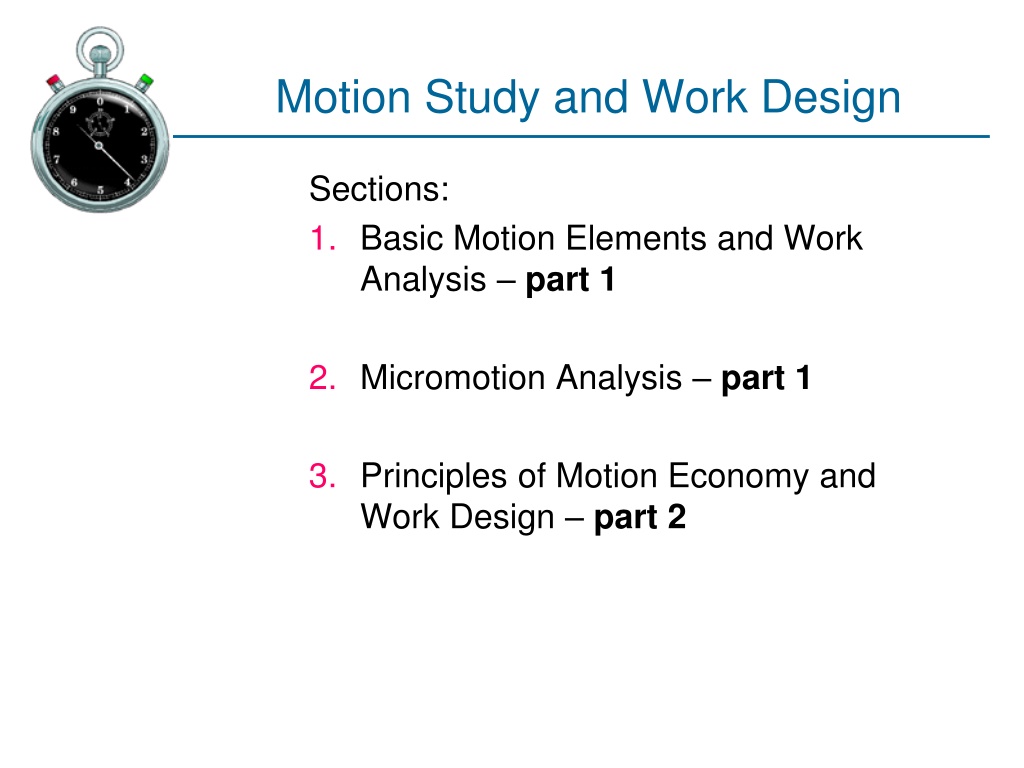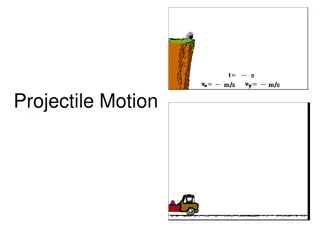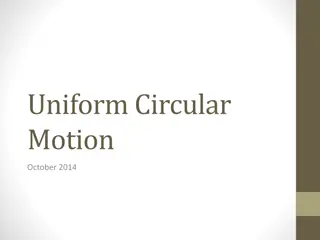Principles of Motion Economy in Work Design
Motion study and work design involve analyzing the movements of workers and designing efficient methods to perform tasks. The principles of motion economy aim to maximize efficiency and reduce worker fatigue by utilizing both hands equally, minimizing hand-eye coordination, and favoring the preferred hand. These principles apply to the human body, workplace arrangement, and tooling and equipment design.
Download Presentation

Please find below an Image/Link to download the presentation.
The content on the website is provided AS IS for your information and personal use only. It may not be sold, licensed, or shared on other websites without obtaining consent from the author. Download presentation by click this link. If you encounter any issues during the download, it is possible that the publisher has removed the file from their server.
E N D
Presentation Transcript
Motion Study and Work Design Sections: 1. Basic Motion Elements and Work Analysis part 1 2. Micromotion Analysis part 1 3. Principles of Motion Economy and Work Design part 2
Definitions Motion study - analysis of the basic hand, arm, and body movements of workers as they perform work Work design - design of the methods and motions used to perform a task Includes: Workplace layout and environment Tooling and equipment used in the task
Motion Study and Work Design 3. Principles of Motion Economy and Work Design
Principles of Motion Economy Developed over many years of practical experience in work design Guidelines to help determine Work method Workplace layout Tools, and equipment Objectives: maximize efficiency and minimize worker fatigue
Three Categories of Principles 1. Principles that apply to the use of the human body 2. Principles that apply to the workplace arrangement 3. Principles that apply to the design of tooling and equipment
1. Use of Human Body 1. Design work to fully utilize both hands Natural tendency of most people: use their preferred hand* to accomplish most of work Other hand: minor role, e.g. holding object, while preferred hand works on it first principle: both hands should be used as equally as possible 2. The two hands should begin and end their motions at the same time follows from 1 Sometimes must design method so work is evenly divided between right-hand & left-hand side of workplace In this case, division of work should be organized according to following principle (3)
1. Use of Human Body 3. Hand and arm motions should be symmetrical and simultaneous i.e. minimize amount of hand-eye coordination required by worker since both hands: doing same movements at same time less concentration required than if 2 hands had to perform different & independent motions 4. Design work to favor preferred hand Preferred hand: faster, stronger, more practical If the work to be done cannot be divided evenly between 2 hands take advantage of worker s best hand e.g. work units should: enter workplace on side of worker s preferred hand & exit workplace on the opposite side**
1. Use of Human Body 5. Worker s two hands should not be idle at the same time Avoid periods when neither hand is working It may not be possible to completely balance workload between the right & left hands but it should be possible to avoid having both hands idle at the same time The exception to this principle: during rest breaks Work cycle of worker-machine system also exception if worker is responsible for monitoring machine during its automatic cycle, and monitoring involves using worker s cognitive senses rather than hands*
1. Use of Human Body Next 5 principles of motion economy attempt to utilize laws of physics to assist use of hands and arms while working 6. Method should consist of: smooth continuous curved motions rather than straight motions with abrupt changes in direction* Reason behind this principle: straight-line path sequence includes start and stop actions (accelerations, decelerations) consume worker s time & energy Motions consisting of smooth continuous curves: minimize lost time in starts & stops
1. Use of Human Body Use momentum to facilitate task When carpenters strike nail with hammer they re using momentum (???? ????????) Imagine applying static force to do this! When work situations provide opportunity to use momentum (like above): use it Previous principle (smooth continuous curved motions) shows beneficial use of momentum to make a task easier Take advantage of gravity Don t oppose it Less time & energy required to move heavy object from higher to lower elevation than to move object upward Principle usually implemented by proper layout and arrangement of the workplace 7. 8.
1. Use of Human Body 9. Method should achieve a natural rhythm of the motions involved Rhythm: motions that have regular recurrence and flow from one to the next Basically, the worker learns rhythm & performs motions without thinking Like natural & instinctive motion pattern in walking
1. Use of Human Body 10. Use lowest classification of hand and arm motion (five classifications) 1) Finger only 2) Finger and wrist 3) Finger, wrist, and forearm 4) Finger, wrist, forearm, and upper arm 5) Finger, wrist, forearm, upper arm, and shoulder For lower classification, worker perform hand and arm motion: more quickly & with less effort work method: should be composed of motions at lowest classification level possible Accomplished by: locating parts & tools as close together as possible in workplace
1. Use of Human Body Two remaining human body principles of motion economy (11 and 12): recommendations for using body members other than hands and arms
1. Use of Human Body 11. Minimize eye focus and travel Eye focus occurs when eye must adjust to change in viewing distance e.g. from 25 in. to 10 in., with little or no change in line of sight Eye travel occurs when eye must adjust to a line- of-sight change e.g. from one location in the workplace to another, but the distances from eyes are same Since eye focus and eye travel each take time, desirable to minimize need for worker to make these adjustments as much as possible Accomplished by minimizing distances between objects (e.g. parts and tools) used in workplace
1. Use of Human Body 12. Design method to utilize feet and legs where appropriate Legs: stronger than arms, although feet are not as practical as hands Work method can sometimes be designed to take advantage of greater strength of legs e.g.: in lifting tasks
2. Workplace Arrangement Normal and maximum working areas in the workplace
2. Workplace Arrangement First 3 principles: Deal with immediate work area Lead to natural rhythm in workplace Remaining principles (4 7): Deal with use of gravity, and General conditions of the workplace
2. Workplace Arrangement 1. Locate tools and materials in fixed positions within the work area a place for everything & everything in its place Worker eventually learns fixed locations, allowing him to reach for object, without wasting time looking & searching
2. Workplace Arrangement 2. Locate tools and materials close to where they are used Helps minimize distances worker must move (TE and TL) in workplace Any equipment controls should also be located in close proximity: Refers to normal & maximum working area (Fig. 10.2) Desirable to keep parts & tools used in within normal working area (for each hand & both hands working together If method requires worker to move beyond maximum working area: worker must move > than just arms & hands more energy, more time, more worker fatigue
2. Workplace Arrangement 3. Locate tools and materials to be consistent with sequence of work elements Items should be arranged in logical pattern that matches sequence of work elements Those items that are used first in cycle should be on 1 side of work area Items used next should be next to first, and so on Alternative: locate items randomly in the work area increases amount of searching required & detracts from rhythm of work cycle Fig. 10.3: shows top view of workplace layout that illustrates 1st3 principles Note, layout in (b) locates bins in more accessible pattern consistent with sequence of work elements
Illustration of First Three Principles Figure 10.3: Two workplace layouts. (a) Poor arrangement of parts and tools in workplace
Illustration of First Three Principles (b) Good arrangement of parts and tools in workplace
2. Workplace Arrangement 4. Use gravity feed bins to deliver small parts and fasteners Two types of bins used for small parts and fasteners in the workplace: a) This s a container that uses gravity to move items in it to a convenient access point for the worker gravity feed bin b) slower acquisition of items than gravity feed bin conventional rectangular bin
2. Workplace Arrangement 5. Use gravity drop chutes for completed work units where appropriate Drop chutes should lead to container adjacent to worktable Entrance to gravity chute should be located near normal work area allows worker to dispose finished work unit quickly & conveniently Most appropriate for lightweight work units that are not fragile
2. Workplace Arrangement 6. Provide adequate illumination Issue of illumination is normally associated with ergonomics Also long known to be important factor in work design Illumination: especially important in visual inspection tasks
2. Workplace Arrangement 7. A proper chair should be provided for the worker: Adjustable to the size of the worker Seat height and back adjustments Padded seat and back Means of increasing & decreasing amount of back support Chair height should be in proper relationship with work height Adjustable chair for workplace: next slide
3. Design of Tooling and Equipment Workholding devices should be designed for the task Mechanical workholder with fast-acting clamp permits work unit to be loaded quickly, and frees both hands to work on the task productively Typical workholder: must be custom-designed for work part processed in task 1.
3. Design of Tooling and Equipment 2. Hands should be relieved of work elements that can be performed by the feet using foot pedals Foot pedal controls instead of hand controls to operate certain types of equipment e.g. Sewing machines, foot pedals used as integral components in operation of equipment Training: often required for operator to become proficient in use of foot pedals
3. Design of Tooling and Equipment 3. Combine multiple functions into one tool where possible Many common hand tools implement this principle e.g. claw hammer: designed for both striking and pulling nails e.g. nearly all pencils are designed for both writing and erasing* Less time usually required to reposition such a double-function tool than to put one tool down and pick another one up
3. Design of Tooling and Equipment 4. Perform multiple operations simultaneously rather than sequentially Work cycle: usu. conceptualized as sequence of work elements or steps Steps are performed one after the other by worker and machine In some cases: work method can be designed so steps are accomplished at same time rather than sequentially* Special tooling and processes can often be designed to simultaneously accomplishmultiple operations
3. Design of Tooling and Equipment 5. Where feasible, perform operation on multiple parts simultaneously Usu. applies to cases involving use of powered/ machine tool, e.g.: drilling of holes in a printed circuit board (PCB) PCBs are stacked 3 or 4 thick NC drill press drills each hole through entire stack in one feed motion
3. Design of Tooling and Equipment 6. Design equipment controls for operator convenience and error avoidance Equipment controls include devices that regulate operation of the equipment Dials Cranks Levers Switches Push buttons, etc. All controls needed by operator should be located within easy reach minimize body motions required to access & activate them
3. Design of Tooling and Equipment 7. Hand tools and portable power tools should be designed for operator comfort and convenience e.g. tools should have handles/grips: slightly compressible can be held & used comfortably for duration of shift Location of handle/grip relative to working end of tool: should be designed for max. operator safety, convenience, and effectiveness of tool If possible, tool should accommodate both right- handed & left handed workers
3. Design of Tooling and Equipment Mechanize or automate manual operations if economically and technically feasible this will almost always outperform worker in terms of speed, repeatability, and accuracy results in higher production rates & better quality products Economic feasibility depends on quantities produced: Higher quantities: likely to justify investment in mechanization & automation 8.























